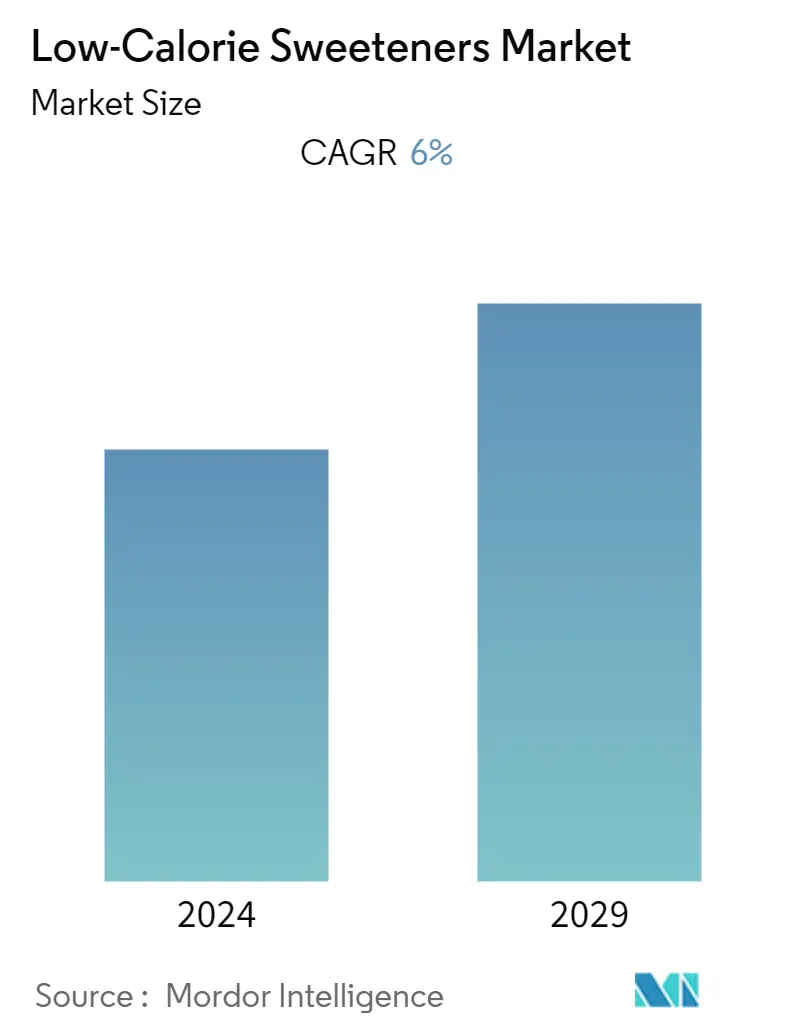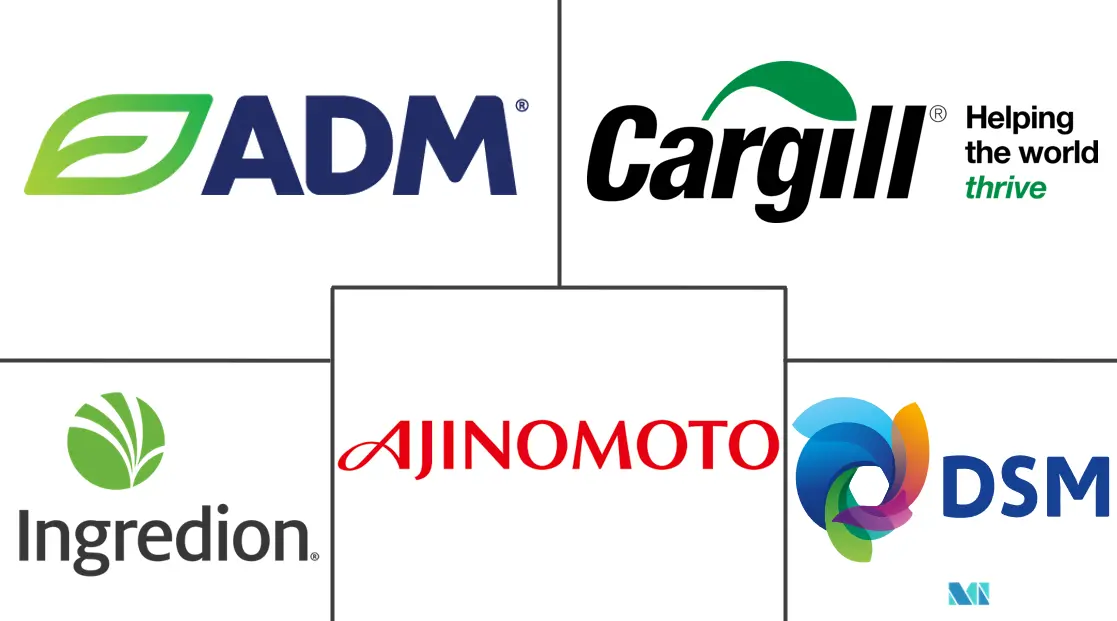Market Size of Low-Calorie Sweeteners Industry

| Study Period | 2019 - 2029 |
| Base Year For Estimation | 2023 |
| CAGR | 6.00 % |
| Fastest Growing Market | Asia-Pacific |
| Largest Market | Europe |
| Market Concentration | Medium |
Major Players
*Disclaimer: Major Players sorted in no particular order |
Low-Calorie Sweeteners Market Analysis
The low-calorie sweeteners market is projected to register a CAGR of 6.0% over the next five years.
Sugar reduction practice has become a common trend among consumers focusing on their dietary shift leading to general wellness and health. Reducing sugar has become a top health priority, particularly among consumers looking to manage their weight. This is increasing the demand for low-calorie sweeteners in the market. Thus, manufacturers are focusing on offering low-calorie sweeteners; for instance, in April 2021, Cargill and DSM launched Eversweet, a non-artificial, zero-calorie sweetener, through its joint venture Avansya which offers natural and healthy sweetening solutions. Moreover, in 2018, FDA approved saccharin sweeteners for use in food across the United States as non-nutritive sweeteners that include brands such as Sweet and Low, Sweet Twin, Sweet'N Low, and Necta Sweet. This benefited the US low-calorie sweeteners market, and exporters around the world are targeting the market.
There is high consumption of beverages with added sugar among American consumers, giving rise to health problems including obesity, diabetes, and heart diseases. Moreover, according to the International Diabetes Federation 2021, the North American and Caribbean regions had a large number of children and adolescents with type 1 diabetes, with around 193,000 in total. Thus, owing to growing diabetic consumers in the region, low-calorie sweeteners are expected to see significant growth over the forecast period.
Low-Calorie Sweeteners Industry Segmentation
Low-calorie sweeteners are sugar substitutes that have low-calorie levels and do not raise blood glucose levels. They can be consumed by consumers looking to reduce their sugar consumption. The global low-calorie sweeteners market (henceforth referred to as the market studied) is segmented by source, product type, application, and geography. By source, the market is segmented into natural and synthetic.
The Low-calorie Sweeteners Market is segmented by Source (Natural and Synthetic), Type (Sucralose, Saccharin, Aspartame, Neotame, Advantam, Acesulfame Potassium, Stevia, and Other Types), Applications (Foods, Beverages, Pharmaceuticals, and Other Applications), and Geography (North America, Europe, Asia-Pacific, South America, and Middle-East and Africa). The report offers market size and forecasts in value (USD million) for the above segments.
| By Source | |
| Natural | |
| Synthetic |
| By Type | |
| Sucralose | |
| Saccharin | |
| Aspartame | |
| Neotame | |
| Advantam | |
| Acesulfame Potassium | |
| Stevia | |
| Other Types |
| By Application | ||||||
| ||||||
| Beverages | ||||||
| Pharmaceuticals | ||||||
| Other Beverages |
| By Geography | |||||||||
| |||||||||
| |||||||||
| |||||||||
| |||||||||
|
Low-Calorie Sweeteners Market Size Summary
The low-calorie sweeteners market is experiencing significant growth, driven by a rising consumer focus on health and wellness, particularly in relation to sugar reduction. This trend is largely due to increasing awareness of the health risks associated with high sugar consumption, such as obesity, diabetes, and cardiovascular diseases. As a result, there is a growing demand for low-calorie sweeteners, with manufacturers like Cargill and DSM introducing innovative products such as Eversweet. Regulatory approvals, such as those from the FDA for saccharin and the European Union for stevia, have further bolstered the market by allowing the use of these sweeteners in various food and beverage applications. The market is characterized by a diverse range of players, from large-scale manufacturers to regional and local companies, all vying to capture market share through product innovation and strategic partnerships.
In Europe, the demand for low-calorie sweeteners is particularly strong, driven by consumer preference for natural and nutritious ingredients. The European market benefits from regulatory support, which encourages the use of low-calorie sweeteners in the beverage industry, where there is a concerted effort to reduce added sugars. The presence of multiple approved sweeteners, such as Acesulfame K, Aspartame, and Sucralose, underscores the region's commitment to offering healthier options. However, stringent and evolving regulations pose challenges to market growth. Key players in the market, including Cargill, Archer Daniels Midland Company, and Ingredion, are actively expanding their product offerings and exploring new technologies to meet the increasing demand for low-calorie and sugar-free products, thereby positioning themselves for continued success in the evolving market landscape.
Low-Calorie Sweeteners Market Size - Table of Contents
-
1. MARKET DYNAMICS
-
1.1 Market Drivers
-
1.2 Market Restraints
-
1.3 Porter's Five Forces Analysis
-
1.3.1 Threat of New Entrants
-
1.3.2 Bargaining Power of Buyers/Consumers
-
1.3.3 Bargaining Power of Suppliers
-
1.3.4 Threat of Substitute Products
-
1.3.5 Intensity of Competitive Rivalry
-
-
-
2. MARKET SEGMENTATION
-
2.1 By Source
-
2.1.1 Natural
-
2.1.2 Synthetic
-
-
2.2 By Type
-
2.2.1 Sucralose
-
2.2.2 Saccharin
-
2.2.3 Aspartame
-
2.2.4 Neotame
-
2.2.5 Advantam
-
2.2.6 Acesulfame Potassium
-
2.2.7 Stevia
-
2.2.8 Other Types
-
-
2.3 By Application
-
2.3.1 Foods
-
2.3.1.1 Bakery
-
2.3.1.2 Frozen Food and Dairy
-
2.3.1.3 Confectionery
-
2.3.1.4 Other Applications
-
-
2.3.2 Beverages
-
2.3.3 Pharmaceuticals
-
2.3.4 Other Beverages
-
-
2.4 By Geography
-
2.4.1 North America
-
2.4.1.1 United States
-
2.4.1.2 Canada
-
2.4.1.3 Mexico
-
2.4.1.4 Rest of North America
-
-
2.4.2 Europe
-
2.4.2.1 United Kingdom
-
2.4.2.2 Germany
-
2.4.2.3 Spain
-
2.4.2.4 France
-
2.4.2.5 Italy
-
2.4.2.6 Russia
-
2.4.2.7 Rest of Europe
-
-
2.4.3 Asia-Pacific
-
2.4.3.1 China
-
2.4.3.2 Japan
-
2.4.3.3 India
-
2.4.3.4 Australia
-
2.4.3.5 Rest of Asia-Pacific
-
-
2.4.4 South America
-
2.4.4.1 Brazil
-
2.4.4.2 Argentina
-
2.4.4.3 Rest of South America
-
-
2.4.5 Middle-East and Africa
-
2.4.5.1 Saudi Arabia
-
2.4.5.2 South Africa
-
2.4.5.3 Rest of Middle-East and Africa
-
-
-
Low-Calorie Sweeteners Market Size FAQs
What is the current Low-Calorie Sweeteners Market size?
The Low-Calorie Sweeteners Market is projected to register a CAGR of 6% during the forecast period (2024-2029)
Who are the key players in Low-Calorie Sweeteners Market?
Cargill Incorporated, Archer Daniels Midland Company, Ajinomoto Co., Inc., Ingredion and DSM are the major companies operating in the Low-Calorie Sweeteners Market.

